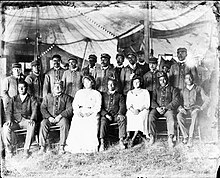P. G. Lowery
P. G. Lowery | |
|---|---|
 P. G. Lowery holding a cornet | |
| Background information | |
| Birth name | Perry George Lowery |
| Born | October 11, 1869 Topeka, Kansas |
| Origin | Reece, Kansas U.S. |
| Died | December 15, 1942 (aged 73) Cleveland, Ohio |
| Genres | |
Perry George Lowery (Topeka, October 11, 1869 – Cleveland, December 15, 1942), commonly known as P. G. Lowery, was an American composer, conductor, cornet player, and a circus sideshow manager of African American entertainment and musical ensembles.
Early life[]
Born October 11, 1870, P. G. Lowery came from a musical family.[1][2] He played the drums in a family band, but later transitioned to cornet.[2]
Musical career[]
P.G. Lowery spent most of his musical career as a performer, manager, and band leader with different traveling circuses. At the turn of the century the U.S. was a deeply segregated country and economic opportunities were limited.[3] Most African Americans worked in agriculture, domestic work, or unskilled labor.[3] P.G. Lowery and many other Black musicians found opportunities in the circus. The traveling circus was a popular form of entertainment before movies.[3] In the early 1900s every circus had an African-American sideshow band and/or minstrel show.[3]
Beginning[]

In 1895 Lowery performed the cornet in a band for the show Darkest America, with the Mallary Brothers Minstrels.[4] The following year he played with the Wallace Circus.[4] Next Lowery became a cornetist with the Original Nashville Students and P. T. Wright’s Colored Comedy Company.[4] In 1897 or1899 he studied at the Boston Conservatory under the direction of Henry C. Brown.[2][4] In the summer of 1898 he played solo cornet at the Trans-Mississippi Exposition in Omaha, Nebraska with the Original Nashville Students.[2] And in 1899 he started the and P.G. Lowery's Vaudeville Company, an important accomplishment because he was the first African American to bring his own vaudeville troupe to the circus.[4][2]
During the early 1900s he published a column, "The Cornet and Cornetists of Today" in The Freeman.[2]
Mid and Late[]
P.G. Lowery led and managed bands in circus sideshow tents for the remainder of his career.[2] Black band leaders, like P.G. Lowery, "strove toward social and economic equality through hard work and artistic and musical achievement."[3] Lowery worked with the following circuses: Sells Brothers and Forepaugh's Circus, Wallace and Hagenbeck, Ringling Brothers, Cole Brothers, and Barnum and Bailey.[2] His longest stint with a circus was from 1919 - 1931 with the Ringling Brothers & Barnum and Bailey Circus where he managed his own band.[4]
References[]
- ^ P. G. Lowery and the Spread of African American Music | The Circus, retrieved March 6, 2021
- ^ Jump up to: a b c d e f g h Southern, Eileen (1982). Biographical dictionary of Afro-American and African musicians. Internet Archive. Westport, Conn. : Greenwood Press. ISBN 978-0-313-21339-7.
- ^ Jump up to: a b c d e Hughes, Sakina M. (July 3, 2017). "Walking the tightrope between racial stereotypes and respectability: images of African American and Native American artists in the golden age of the circus". Early Popular Visual Culture. 15 (3): 315–333. doi:10.1080/17460654.2017.1383028. ISSN 1746-0654. S2CID 191530394.
- ^ Jump up to: a b c d e f Richard, Schwartz (2000). "The African American Contribution to the Cornet of the Nineteenth Century. Some Long lost Names" (PDF). Historic Brass Society Journal. 12: 61–75.
External links[]
- First look clip of new PBS Doc, "The Circus". Short two-minute video about racial discrimination and how PG Lowery changed his sideshow by hiring women and getting rid of blackface.
- P.G. Lowery and the spread of African American Music. Two minute video about Lowery's career and traveling musicians.
- African-American history
- Bandleaders
- Cornetists
- 1869 births
- 1942 deaths